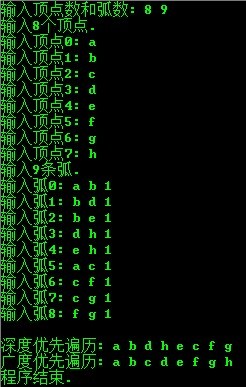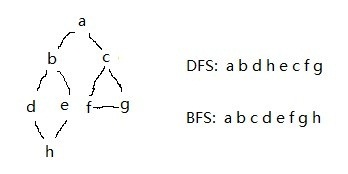各种基本算法实现小结(四)—— 图及其遍历
1 // graph.cpp : 定义控制台应用程序的入口点。 2 //邻接矩阵表示 3 #include "stdafx.h" 4 #include <malloc.h> 5 #define INFINITY 32767 6 #define MAX_VEX 20 7 #define QUEUE_SIZE 20 8 bool *visited; //用来判断是否遍历过,为true则遍历过,为false,则未遍历过 9 10 typedef struct{ 11 char* vexs; //顶点向量(包含的顶点a,b,c,d ...) 12 int arcs[MAX_VEX][MAX_VEX]; //邻接矩阵 13 int vexnum,arcnum; //图的顶点数和弧数 14 }Graph; 15 16 class Queue{ 17 public: 18 Queue(){}; 19 virtual ~Queue(){ 20 delete this->base; 21 } 22 int* base; 23 int front; 24 int rear; 25 26 public: 27 void InitQueue(){ 28 base=(int *)malloc(QUEUE_SIZE*sizeof(int)); 29 front=rear=0; 30 } 31 void EnQueue(int e){ 32 base[rear]=e; 33 rear=((rear+1) % QUEUE_SIZE); 34 } 35 void DeQueue(int &e){ 36 e=base[front]; 37 front=(front+1)%QUEUE_SIZE; 38 } 39 }; 40 41 42 int Locate(Graph G,char c){ 43 for(int i=0;i<G.vexnum;i++) 44 if(G.vexs[i] == c) 45 return i; 46 return -1; 47 } 48 49 void CreateUDN(Graph &G){ 50 int i,j,w,s1,s2; 51 char a,b,temp; 52 printf("输入顶点数和弧数:"); 53 scanf_s("%d%d",&G.vexnum,&G.arcnum); 54 temp=getchar(); //接收回车 55 G.vexs=(char*)malloc(G.vexnum*sizeof(char)); 56 printf("输入%d个顶点.\n",G.vexnum); 57 for(i=0;i<G.vexnum;i++){ 58 printf("输入顶点%d:",i); 59 scanf_s("%c",&G.vexs[i]); 60 temp=getchar(); 61 } 62 for(i=0;i<G.vexnum;i++) //初始化邻接矩阵 63 for(j=0;j<G.vexnum;j++) 64 G.arcs[i][j]=INFINITY; 65 66 printf("输入%d条弧.\n",G.arcnum); 67 68 for(i=0;i<G.arcnum;i++){ 69 printf("输入弧%d:",i); 70 scanf_s("%c %c %d",&a,1,&b,1,&w); 71 temp=getchar(); 72 s1=Locate(G,a); 73 s2=Locate(G,b); 74 G.arcs[s1][s2]=G.arcs[s2][s1]=w; 75 } 76 } 77 78 //获取图G中顶点K的第一个邻接顶点 79 int FirstVex(Graph G,int k){ 80 if(k>=0 && k<G.vexnum) //k合理 81 for(int i=0;i<G.vexnum;i++) 82 if(G.arcs[k][i]!=INFINITY) 83 return i; 84 return -1; 85 } 86 87 //获取图G中以i为顶点的第j个邻接顶点的下一个邻接顶点 88 int NextVex(Graph G,int i,int j){ 89 if(i>=0 && i<G.vexnum && j>=0 && j<G.vexnum) 90 for(int k=j+1;k<G.vexnum;k++) 91 if(G.arcs[i][k]!=INFINITY) 92 return k; 93 return -1; //如果遍历完还没有返回k的就返回-1; 94 } 95 96 void DFS(Graph G,int k){ 97 int i; 98 if(k == -1){ //第一次执行DFS时,k为-1 99 for(i=0;i<G.vexnum;i++) 100 if(!visited[i]) 101 DFS(G,i); //对尚未访问的顶点调用DFS 102 } 103 else{ 104 visited[k] = true; 105 printf("%c ",G.vexs[k]); //访问第k个顶点 106 for(i=FirstVex(G,k);i>=0;i=NextVex(G,k,i)) 107 if(!visited[i]) //对k的尚未访问的邻接顶点i递归调用DFS 108 DFS(G,i); 109 } 110 } 111 112 void BFS(Graph G){ 113 int k,w; 114 Queue Q; //辅助队列Q 115 Q.InitQueue(); 116 for(int i=0;i<G.vexnum;i++) 117 if(!visited[i]){ 118 visited[i]=true; 119 printf("%c ",G.vexs[i]); 120 Q.EnQueue(i); 121 while(Q.front!=Q.rear){ 122 Q.DeQueue(k); 123 for(w=FirstVex(G,k);w>=0;w=NextVex(G,k,w)){ 124 if(!visited[w]){ 125 visited[w]=true; 126 printf("%c ",G.vexs[w]); 127 Q.EnQueue(w); 128 } 129 } 130 } 131 } 132 } 133 134 int _tmain(int argc, _TCHAR* argv[]) 135 { 136 int i; 137 Graph G; 138 CreateUDN(G); 139 visited=(bool*)malloc(G.vexnum*sizeof(bool)); 140 141 printf("\n深度优先遍历:"); 142 for(i=0;i<G.vexnum;i++) 143 visited[i]=false; 144 DFS(G,-1); 145 146 printf("\n广度优先遍历\n"); 147 for(i=0;i<G.vexnum;i++) 148 visited[i]=false; 149 150 BFS(G); 151 free(G.vexs); 152 printf("\n程序结束\n"); 153 return 0; 154 }
测试环境: VS 2010
运行结果:


本文参考自:~~~




